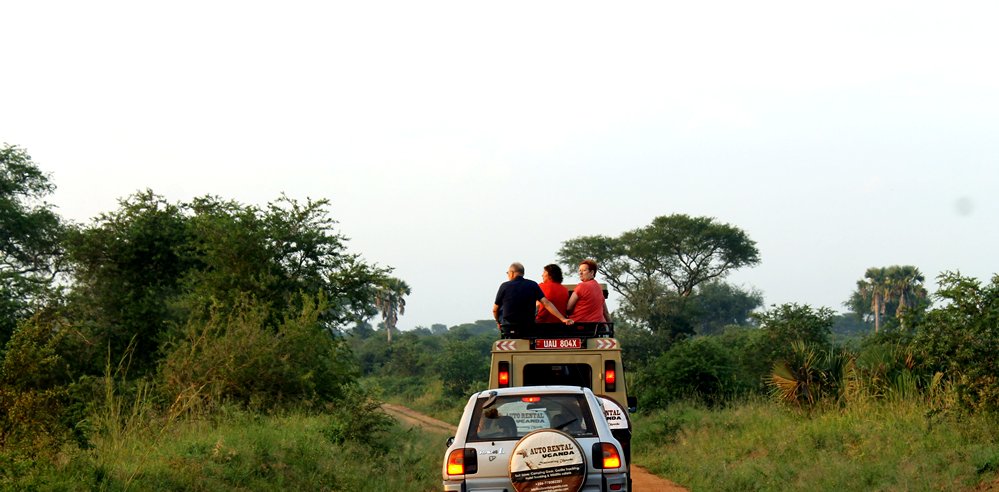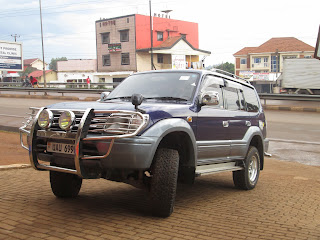What to do on a self drive in kampala to the Namugongo shrine.
Self drive in Uganda and particulary kampala is one of the
most interesting activities to keep you entertained in Uganda. Hiring a small
suv Rav4 vehicle from good agencies like Auto Rental Uganda will do you a good
deal. The namgongo shrine is about 25kms from the city centre of kampala as
public means known as the taxis are common and boda bodas are many to take you
there. However the point of safety matters so a self drive from your car rental
agency will give you a good deal. Lets take you discover the pearl of Africa
with the namgongo shrine.
The Uganda martyrs catholic parish was established in 1935
by the mill hill missionaries from England. This site in Namugongo village was
chosen as the parish headquarters because its one of the over twelve spot
countrywide were Christians were executed. Particularly executed in Namugongo
are the first groups of Christian converts in Buganda. These Christians were
executed the king of Buganda locally known as the “kabaka” then kabaka mwanga
(ii), mwanga ascended to power at an early of around 18 or 19 year after the
death of his father kabaka mutesa (I). It’s said that his father mutesa is the
kabaka who invited missionaries to come to Buganda. He is said to have written
a request letter through an early explorer Henry mutton Stanley to then queen Victoria of England in
1875. He then received two Christian missionary groups thus the church
missionary society in 1877 and the missionaries of Africa
in 1879, they were both accommodated with in the king s capital where already
existed Islam and the African traditional practiced leading to Rivalry for
converts. This revelry absented the king though he later enjoyed playing one
against the other.
Because of political interest the king sided with the
Muslims thus expelling the Christian missionaries from Buganda in 1882, however
the heath of the kabaka worsened very fast thus the ill kabaka passed on in
1884 giving way to the rise of kabaka mwanga (ii), On ascending to power,
mwanga sent a flight of canoes to Tanganyika to collected the missionaries who
resumed their work with energy once again, however the religious differences
that sparked off again, The fast growing number of Christian and their
commitment to their new faith became a big threat to the young king who changed
his mind to execute them.
Kabaka mwanga took three years killing Christian, thus
started in 1885, this executions come to the climax on the 3rd of
June 1886 and it stopped in 1887, with in this period 45 Christians were
killed, 22 Catholics and 23 Anglican but of the 45 Christian killed, 26 of the
were killed on the 3rd of June 1886 in Nmugongo, thus 13 catholic
and Anglicans.
Namugongo was chosen by the kabaka for the execution of the
26 Christians because this was one of the thirteen execution site and also one
of the most brutal in Buganda,
and also known for being an execution site for royals and royal servants. Being
an execution site is where the village gets from its name “namugongo” from the
luganda word “omugongo” meaning “the back”, it said that the kabaka that
declared it an execution site in around 1860 would order for his prisoners to
be tired and dragged on their backs from the palaces to the execution site. The
local people who would see the prisoners being pulled on their backs would say
they were walking on their backs.
With the change of kings prisoner were accepted to start
walking to the execution sites but they had to be burnt alive in the presence
of their mothers
Bill board
The lower left hand painting
Mathias kalemba the mulumba, he was one the oldest martyrs
aged around 50 year, he attained the title “the mulumba” after being appointed
the junior chief of singo which chiefdom duty was to construct the kings
enclosures. At the outburst of the executions, he had travelled for over ninety
mile from mityana to mengo to do his loyal duty of reconstructing the kabakas
palace that had got bunt down. On his arrival he was arrested and as he was
being forwarded to Namugongo he stopped at old Kampala were he refused to walk any further,
to tougher him, his hands, legs lips and flesh from his back were removed and
roasted. His veins were then roasted to stop the speedy loose of blood, he was
then left behind where he died after three days of suffering.
Lower middle painting
Charles lwanga
He was the head or the leader of the Christians by the June
of 1886, having encouraged his followers not to renounce their faith despite
the fact that the executioners kept toughing and killing a Christian at all
corners. They thought it as a tactic to separate him from the other prisoners
and burnt separately, traditionally burning one person away from the group was
a method of preventing the spirits of the victims from avenging at the king.
Charles was burnt where the current basilica strands.
The church
It’s a church, shrine and a basilica, thus a shrine being a
holly place and a basilica a name give to a church constructed in a place where
an important Christian event has take place. The architect of the structure was
derived from the looks of a traditional African hut or a traditional hut, It
also has copper all around which represent the fire wood and the vertical ones
represent the twenty two catholic martyrs. The top capped structure of the
church symbolizes the flame used in the burning.
The basilica also has an altar at the center which is a said
to be the execution spot where Charles lwanga was executed. After the
execution, it’s told that the missionaries encouraged Christians to make the
spot prayer place. As the result of miracles, it’s said that the Christians
carried away the ashes and the soils from the spot which up to date is covered
hole in side he church. Right in front of the altar is the relic of Charles.
The grotto
The first one located in front of the church has a wooden
curving showing Charles lwanga baptizing kizito who was the youngest martyr of
about 12 or 13 years. This baptism was on the early morning of the 26th
of May. It’s said that Charles baptized with kizito four other young coverts
who had hardly finished their four years catechism.
The second grotto has the demonstration to show how charley
lwanga was burnt, its shows Charles trapped in reeds with a slave yolk on his
neck. This illustration got from the eye witness account by Denis kamyika and
Abdul Aziz the Christian and Moslem respectively of the three survivor of the
fire, it show Charles being beaten by Ssebabi
and set on fire by muduwawulire all executioners. It also shows senkoole
the assistant chief executioner in command.
This demonstration was put under an African frame tree a
similar tree species under which Charles was burnt. The choice of this tree
spies was to humiliate him because in the traditional buganda custom
cuscuses of dogs are not buried but rather dumped under African flame trees.
The 3rd of June which is called the Uganda martyrs day in Uganda is a national public
holiday, Christians from all over the world consider this day a pilgrimage day
which climax is with mass attended by millions of people. The majority of this
people are Africans who come footing from all parts of Uganda and from
the neighboring countries. on the about 33 hectares of land is the celebration
pavilion, with the main celebrants seated in the middle circular one which is
in form of an island in the small excavated pond commonly known as the martyrs
lake, this pond during times of Namugongo as an execution ground was used by
the executioners for washing up and bathing, but spiritually they used its
waters for cleansing. It’s said that they would wash their hand and legs then
make verbal statements like “we are not the ones responsible for your death but
the kabaka, kibuka, makasa,” amongist other kiganda gods.
This water by many Christians is also considered holly since
the rituals of the Charles lwange was performed in it, thousands of Christians
collect this water for spiritual purposely majority expecting miracles.
Surrounding the lake to the right is pavilion for the clergy, left is for the
delegates and politicians, to the left but closest to the central pavilion is
another pavilion for the choir members with a stretching entering the water.
Far left but a little behind of the pavilion for the choir members is a
pavilion made for the mass media.
The pilgrims that come walking for over a month start
arriving one week to the martyrs day, the growing number have forced Christians
who would like to seat closest to the pavilion of the main celebrants to book
their space almost seven days in advance.




Comments
Post a Comment